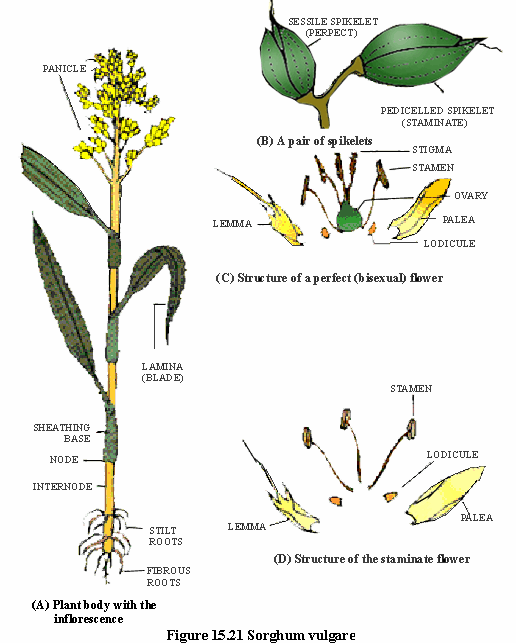|
PinkMonkey Online Study Guide-Biology
15.4 Angiosperms : Monocotyledons
Monocotyledons are angiosperms (flowering plants) with
an adventitious root system, parallel venation, trimerous symmetry of
flowers and a single cotyledon in the embryo.
Sorghum, rice, wheat and corn arethe most commonly cultivated
crops of the monocotyledons.
Sorghum vulgare : (Great millet)
Classification (Bentham and Hooker, 1862-1883)
|
Kingdom |
- |
Plantae |
|
Sub-kingdom |
- |
Phanerogams |
|
Division |
- |
Angiospermae |
|
Class |
- |
Monocotyledones |
|
Series |
- |
Glumaceae |
|
Family |
- |
Gramineae |
|
Genus |
- |
Sorghum |
|
Species |
- |
Vulgare |
Life Cycle
The life cycle of sorghum is predominantly sporophytic
and shows heteromorphic alternation of generations.
i) Plant body- External morphology (Fig. 15.21 A)
The sorghum plant is a diploid sporophyte. It is an herbaceous,
tall annular plant which is sown during the monsoons. The plant is differentiated
into roots, stem and leaves.
The root system consists of two types of roots; primary and adventitious. The primary roots, called seminal roots develop first and penetrate vertically downwards in the soil. The adventitious roots develop from basal nodes. These are fibrous, branched, well developed and also function as stilt roots to support the tall plant. -
The stem is erect, solid, up to 10 feet tall
and with distinct nodes and internodes. Few basal internodes are short.
The internodes are smooth and cylindrical with a longitudinal furrow
along one side.
-
The leaves are simple, sessile and alternate.
The leaf blade (lamina) is long and lanceolate with an acute apex.
The surface is rough and hairy. Venation is multicostate and parallel,
but with a very well developed mid-rib. Leaf base is long and sheathing.
There is a short membranous ligule at the junction of the sheathing
base and the lamina.
ii) Inflorescence: In sorghum, inflorescence is
a terminal panicle (cluster) and develops as a more or less compact
head. It consists of a profusely branched inflorescence axis (rachis).
The ultimate branchlets of the rachis bear one to many pairs of
spikelets. In each pair, one spikelet is sessile and perfect
(bisexual) while the other is pedicelled and staminate.
(Fig. 15.21B).
 Click here to enlarge
Click here to enlarge
|